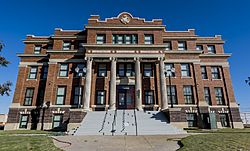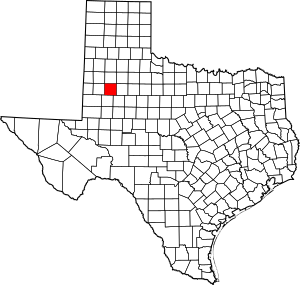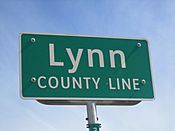Lynn County, Texas facts for kids
Quick facts for kids
Lynn County
|
|
|---|---|

Lynn County Courthouse in Tahoka
|
|

Location within the U.S. state of Texas
|
|
 Texas's location within the U.S. |
|
| Country | |
| State | |
| Founded | 1903 |
| Seat | Tahoka |
| Largest city | Tahoka |
| Area | |
| • Total | 893 sq mi (2,310 km2) |
| • Land | 892 sq mi (2,310 km2) |
| • Water | 1.6 sq mi (4 km2) 0.2% |
| Population
(2020)
|
|
| • Total | 5,596 |
| • Density | 6.267/sq mi (2.4195/km2) |
| Time zone | UTC−6 (Central) |
| • Summer (DST) | UTC−5 (CDT) |
| Congressional district | 19th |
Lynn County is a county located in the state of Texas in the United States. In 2020, about 5,596 people lived here. The main town and county seat is Tahoka.
The county was first created in 1876. It officially started operating in 1903. Lynn County is part of the larger Lubbock area. This means it's connected to nearby cities like Lubbock and Crosby County.
For a long time, Lynn County was a "dry county." This meant you couldn't legally buy or sell alcohol there. Now, it's a "moist county," which means some alcohol sales are allowed.
If you visit Lynn County, you can explore two history museums. The O'Donnell Heritage Museum in O'Donnell even has a special room about actor Dan Blocker. There's also the Tahoka Pioneer Museum in Tahoka. The county also has its own hospital district, providing healthcare for everyone living there.
Contents
History of Lynn County
Early Native American Life
Long ago, Apache and Comanche tribes lived and hunted on the wide plains of Lynn County. They roamed freely until the 1800s. During this time, military groups pushed them out of the area.
One important event was the Red River War in 1874. This was a military effort to remove the Apache, Comanche, and Kiowa tribes from Texas. By the time settlers arrived, most Native American tribes had left. This was partly because hunters had greatly reduced the number of buffalo, which was a main food source for the tribes.
First Settlers Arrive
In the early 1880s, people started to set up large sheep and cattle ranches in Lynn County. These ranches were huge. For example, the Curry Comb Ranch and the Square Compass Ranch spread into Lynn County from a neighboring area.
For about 20 years after 1880, Lynn County had very few people. There were no towns, and the population was tiny: only 9 people in 1880, 24 in 1890, and 17 in 1900. Later, farmers began to move in. They started growing crops like corn, grains, and cotton.
How the County Was Formed
Lynn County was officially created in 1876 from a larger area called Bexar. It was fully organized in 1903. That's when Tahoka became the main town and the county seat.
In the early 1900s, new towns appeared. O'Donnell was founded in 1910. It was named after a railroad man, Tom J. O'Donnell. The town was started to attract farmers to new lands. Wilson was established in 1912 for a similar reason. Many German families from Central Texas bought land here, leading to a small wave of German settlers.
Cotton farming became very successful in the early 20th century. Farmers also grew wheat and sorghum. They raised animals like cattle, sheep, hogs, and chickens. In 1950, oil was discovered in the county. This brought new industry and jobs to the area.
Geography of Lynn County
Lynn County covers about 893 square miles. Most of this area, about 892 square miles, is land. Only a small part, about 1.6 square miles, is covered by water.
Natural Features
- Caprock Escarpment: This is a steep slope that forms the eastern edge of Lynn County.
- Double Mountain Fork Brazos River: This river starts as a small dip in the land near towns like Draw and Grassland.
- Double Lakes: These lakes are located northwest of Tahoka.
- Guthrie Lake: You can find this lake southwest of Tahoka.
- Tahoka Lake: This lake is located northeast of Tahoka.
Main Roads
Neighboring Counties
Lynn County shares its borders with several other counties:
- Lubbock County (to the north)
- Garza County (to the east)
- Borden County (to the southeast)
- Dawson County (to the south)
- Terry County (to the west)
- Hockley County (to the northwest)
Population Information
| Historical population | |||
|---|---|---|---|
| Census | Pop. | %± | |
| 1880 | 9 | — | |
| 1890 | 24 | 166.7% | |
| 1900 | 17 | −29.2% | |
| 1910 | 1,713 | 9,976.5% | |
| 1920 | 4,751 | 177.3% | |
| 1930 | 12,372 | 160.4% | |
| 1940 | 11,931 | −3.6% | |
| 1950 | 11,030 | −7.6% | |
| 1960 | 10,914 | −1.1% | |
| 1970 | 9,107 | −16.6% | |
| 1980 | 8,605 | −5.5% | |
| 1990 | 6,758 | −21.5% | |
| 2000 | 6,550 | −3.1% | |
| 2010 | 5,915 | −9.7% | |
| 2020 | 5,596 | −5.4% | |
| U.S. Decennial Census 1850–2010 2010 2020 |
|||
In 2000, Lynn County had 6,550 people living there. The population density was about 7 people per square mile. About 44% of the people identified as Hispanic or Latino.
The average age of people in the county was 35 years old. About 31% of the population was under 18 years old.
Lynn County has a weekly newspaper. You can also listen to local radio stations like KBXJ (FM) and KPET (AM). Many people also get their news and entertainment from radio and TV stations in nearby Lubbock.
Towns and Communities
Cities
- New Home
- O'Donnell (a small part is in Dawson County)
- Tahoka (This is the county seat, the main town)
- Wilson
Small Communities
Famous People from Lynn County
- Dan Blocker: A well-known actor.
- Jerry "Bo" Coleman: A popular radio disc jockey.
- Phil Hardberger: A politician.
- E L Short: A former member of the Texas State Legislature.
Education in Lynn County
Several school districts serve the students in Lynn County:
- Dawson Independent School District
- New Home Independent School District
- O'Donnell Independent School District
- Post Independent School District
- Slaton Independent School District
- Southland Independent School District
- Tahoka Independent School District
- Wilson Independent School District
For higher education, Lynn County is part of the area served by South Plains College.
See also
 In Spanish: Condado de Lynn para niños
In Spanish: Condado de Lynn para niños



